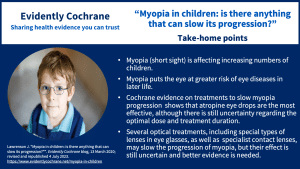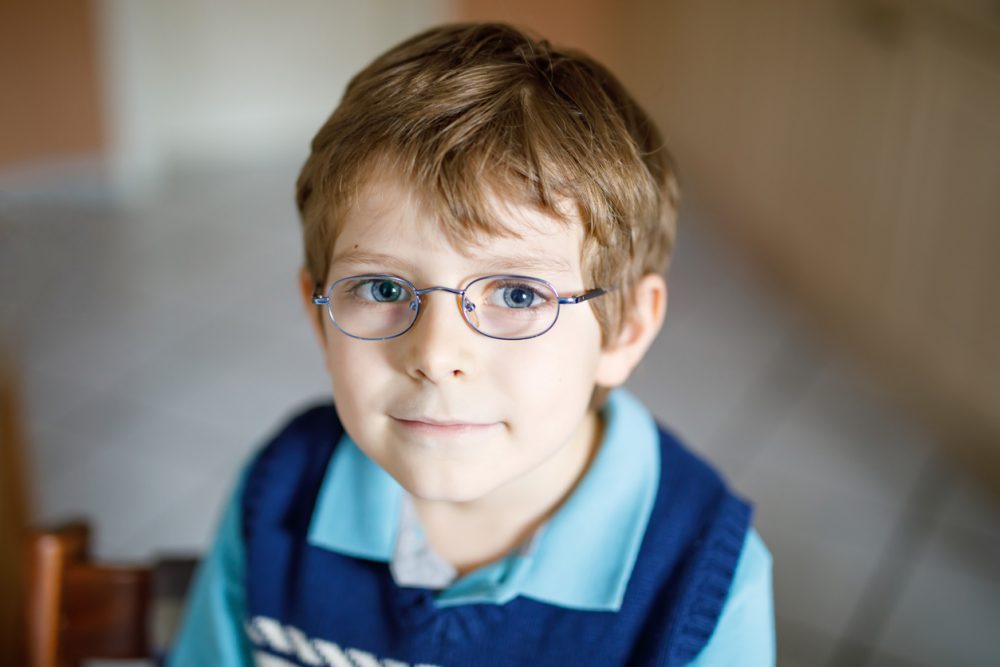Cochrane Eyes and Vision Editor and Optometrist, John Lawrenson blogs about the latest Cochrane evidenceCochrane Reviews are systematic reviews. In systematic reviews we search for and summarize studies that answer a specific research question (e.g. is paracetamol effective and safe for treating back pain?). The studies are identified, assessed, and summarized by using a systematic and predefined approach. They inform recommendations for healthcare and research. on interventions for controlling myopia in children and asks ‘What is the most effective treatmentSomething done with the aim of improving health or relieving suffering. For example, medicines, surgery, psychological and physical therapies, diet and exercise changes.?’
This blog was originally published 13 March 2020; revised and republished with new evidence 4 July 2023.
Take-home points

Myopia, a 21st-century global public health problem
With myopia (near or short-sightedness) predicted to affect 50% of the world populationThe group of people being studied. Populations may be defined by any characteristics e.g. where they live, age group, certain diseases. by 2050, the condition is rapidly becoming a global public health concern. Myopia, which causes distant objects to become blurred, is already reaching epidemic proportions in certain parts of East and South East Asia. For example, in urban areas of South East Asia, 80-90% of children are myopic by the time they complete their high school education, an increase of over 20% in the last decade. Although often regarded as simply a minor inconvenience, higher degrees of myopia are associated with sight-threatening eye problems such as glaucoma, myopic degeneration of the retina and retinal detachment later in life.
Interventions to slow myopia
At birth, newborns are usually longsighted (hyperopic), which then slowly declines to the point that by five to seven years of age, children typically have either normal eyesight or a low degree of hyperopia. Myopia is uncommon in children under six even in East Asia, however in high-risk populations the number with myopia increases dramatically after this age, possibly linked to the intensity of the educational system. Although conventional eyeglasses or contact lenses are able to correct short sight, they do not slow its progression. In recent years, there has been a considerable amount of interest in the development and testing of interventions to slow the rateThe speed or frequency of occurrence of an event, usually expressed with respect to time. For instance, a mortality rate might be the number of deaths per year, per 100,000 people. of progression of myopia. Since myopia tends to stabilise in late adolescence, interventions to slow myopia progression need to be delivered in childhood.
These interventions generally use one of three approaches:
- Optical treatments that use multifocal glasses or special contact lenses.
- Specially designed rigid contact lenses (orthokeratology) that are usually worn at night to reshape the cornea at the front of the eye to correct myopia and slow progression.
- Pharmacological interventions that involve the use of eye drops such as atropine, which act on the eyes focussing system and lead to biochemical changes that slow the rate of eye growth.
The latest evidence
A 2023 Cochrane ReviewCochrane Reviews are systematic reviews. In systematic reviews we search for and summarize studies that answer a specific research question (e.g. is paracetamol effective and safe for treating back pain?). The studies are identified, assessed, and summarized by using a systematic and predefined approach. They inform recommendations for healthcare and research. on interventions for myopic control in children included 64 studies with 11,617 children, compared several optical and pharmacological interventions to slow progression of myopia. The review provided moderate-certaintyThe certainty (or quality) of evidence is the extent to which we can be confident that what the research tells us about a particular treatment effect is likely to be accurate. Concerns about factors such as bias can reduce the certainty of the evidence. Evidence may be of high certainty; moderate certainty; low certainty or very-low certainty. Cochrane has adopted the GRADE approach (Grading of Recommendations Assessment, Development and Evaluation) for assessing certainty (or quality) of evidence. Find out more here: https://training.cochrane.org/grade-approach evidence that higher doses of atropine were probably an effective treatment for myopia control, with less certain effects for low-dose atropine. However, some children experienced side effects related to the drops, such as focusing difficulties, sensitivityA measure of a screening or diagnostic test’s ability to correctly detect people who have the disease. to light and eye discomfort. In one of the largest studies, approximately 15% of children stopped therapy due to side effects.
Based on short-term studies, orthokeratology is the most effective of the optical treatments in slowing elongation of the eyeball. These lenses were often difficult to tolerate, with more than half of children not completing the treatment in some studies. Other types of contact lenses, known as multifocal soft contact lenses, may also reduce the progression of short-sightedness, but there is still some uncertainty about their beneficial effects. Furthermore, 60% of studies included in the review were conducted in East Asia and it is unclear whether the reported effectivenessThe ability of an intervention (for example a drug, surgery, or exercise) to produce a desired effect, such as reduce symptoms. would extend to other ethnic groups.
Where does this leave us?
Atropine eye drops currently seem to be the most effective treatment for myopia control, but further research is needed to determine the optimal dose and duration of therapy. Although lower atropine doses may reduce side effects, this may be associated with a decrease in effectiveness but could potentially be used in combination with optical treatments. Optical treatments, including special types of lenses in eyeglasses as well as contact lenses, may also slow the progression of short‐sightedness, but their effect is still uncertain.
Advice to parents of children at riskA way of expressing the chance of an event taking place, expressed as the number of events divided by the total number of observations or people. It can be stated as ‘the chance of falling were one in four’ (1/4 = 25%). This measure is good no matter the incidence of events i.e. common or infrequent. of developing myopia
An increasing number of eye care practitioners are offering a variety of pharmacological and optical interventions to slow the rate of myopia progression. It is therefore important that parents are provided with the most current and relevant evidence on the likely success of these treatments. This updated Cochrane Review is therefore very timely.
The most effective interventionA treatment, procedure or programme of health care that has the potential to change the course of events of a healthcare condition. Examples include a drug, surgery, exercise or counselling. in the reported studies was atropine eye drops; however, the concentration of atropine used (0.5%, 1%) was higher than the lower dose (0.01%) currently being offered by most practitioners.
In terms of optical treatments, orthokeratology (ortho-K) currently appears to be the most effective treatment for slowing childhood myopia progression, but these lenses require more specialised knowledge by the eye care practitioner and may be difficult to tolerate.
Evidence on the effectiveness of other treatments was limited by short studyAn investigation of a healthcare problem. There are different types of studies used to answer research questions, for example randomised controlled trials or observational studies. durations and considerable variability in treatment response.
Join in the conversation on Twitter with @jglawrenson @CochraneUK or leave a comment on the blog.
Please note, we will not publish comments that link to commercial sites or appear to endorse commercial products. Please note, we cannot give specific medical advice and do not publish comments that link to individual pages requesting donations or to commercial sites, or appear to endorse commercial products. We welcome diverse views and encourage discussion but we ask that comments are respectful and reserve the right to not publish any we consider offensive. Cochrane UK does not fact-check – or endorse – readers’ comments, including any treatments mentioned.
John Lawrenson has nothing to disclose.


